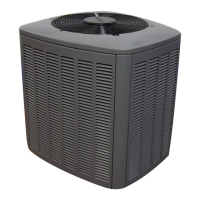Page 20
505367M 04/08
DO NOT CHARGE UNIT
(Results of charging at low
temperatures not reliable)
START: Measure outdoor ambient temperature
USE WEIGH-IN METHOD
Weigh-in or remove refrigerant
based upon line length
APPº (Approach) Values(F:+/−1.0° [C: +/−0.6°])
1. Confirm proper airflow across coil using figure 33.
2. Compare unit pressures with table 7, Normal
Operating Pressures.
3. Set thermostat to call for heat (must have a cooling
load between 70-80ºF (21−26ºC).
4. Connect gauge set.
5. When heat demand is satisfied, set thermostat to call
for cooling.
6. Allow temperatures and pressures to stabilize.
7. Record outdoor ambient temperature:
AMBº =_________
8. Record liquid line temperature:
LIQº = __________
9. Subtract to determine approach (APPº):
LIQº_____ − AMBº _____ = APPº_____
10. Compare results with table below.
Figure 36. Using HFC−410A Approach TXV Charge Method
64ºF and
BELOW
65ºF
and
ABOVE
ABOVE or
BELOW
If value is MORE
than shown, remove
refrigerant.
If value is LESS
than shown, add
refrigerant.
If refrigerant is added
or removed, verify
charge using the
Subcooling Method.
MORE or
LESS
ºF (ºC)* −018 −024 −030 −036 −042 −048 −060
65 (18) 4 (2.2) 5 (2.8) 4 (2.2) 5 (2.8) 6 (3.3) 7 (3.9) 8 (4.4)
75 (24) 5 (2.8) 6 (3.3) 5 (2.8) 5 (2.8) 8 (4.4) 8 (4.4) 9 (5.0)
85 (29) 6 (3.3) 6 (3.3) 6 (3.3) 6 (3.3) 8 (4.4) 8 (4.4) 9 (5.0)
95 (35) 5 (2.8) 7 (3.9) 6 (3.3) 6 (3.3) 8 (4.4) 8 (4.4) 9 (5.0)
105 (41) 3 (1.7) 6 (3.3) 6 (3.3) 5 (2.8) 8 (4.4) 8 (4.4) 9 (5.0)
115 (45) 3 (1.7) 6 (3.3) 6 (3.3) 6 (3.3) 8 (4.4) 9 (5.0) 9 (5.0)
*Temperature of air entering outdoor coil
DO NOT CHARGE UNIT
(Results of charging at low
temperatures not reliable)
START: Measure outdoor ambient temperature
USE WEIGH-IN METHOD
Weigh-in or remove refrigerant
based upon line length
SCº (Subcooling) Values (F:+/−1.0° [C: +/−0.6°])
BLOCK OUTDOOR COIL: [sometimes necessary with lower
temperatures] Use cardboard or plastic sheet to restrict the airflow
through the outdoor coil to achieve pressures from 325−375 psig
(2240−2585 kPa). Higher pressures are needed to check charge.
Block equal sections of air intake panels and move coverings
sideways until the liquid pressure is in the above noted ranges.
If value is MORE
than shown, remove
refrigerant.
1. Confirm proper airflow across coil using figure 33.
2. Compare unit pressures with table 7, Normal
Operating Pressures.
3. Set thermostat to call for heat (must have a cooling
load between 70-80ºF (21−26ºC)
4. Connect gauge set
5. Measure outdoor ambient temperature
6. When heat demand is satisfied, set thermostat to call
for cooling
7. Allow temperatures and pressures to stabilize.
NOTE − If necessary, block outdoor coil to maintain
325 − 375 psig.
8. Record liquid line temperature:
LIQº = ______
9. Measure liquid line pressure and use the value to
determine saturation temperature (see table 6):
SATº = ______
10. Subtract to determine subcooling (SCº):
SATº_____ − LIQº _____ = SCº _____
11. Compare results with table below.
Figure 37. Using HFC−410A Subcooling TXV Charge Method
MORE or
LESS
If value is LESS
than shown, add
refrigerant.
If refrigerant is added
or removed, verify
charge using the
Approach Method.
64ºF and
BELOW
65ºF
and
ABOVE
ABOVE or
BELOW
ºF (ºC)* −018 −024 −030 −036 −042 −048 −060
65 (18) 10 (5.6) 10 (5.6) 10 (5.6) 11 (6.1) 10 (5.6) 8 (4.4) 8 (4.4)
75 (24) 6 (3.3) 8 (4.4) 8 (4.4) 11 (6.1) 7 (3.9) 8 (4.4) 7 (3.9)
85 (29) 6 (3.3) 8 (4.4) 7 (3.9) 11 (6.1) 7 (3.9) 8 (4.4) 8 (4.4)
95 (35) 6 (3.3) 8 (4.4) 7 (3.9) 10 (5.6) 7 (3.9) 8 (4.4) 7 (3.9)
105 (41) 10 (5.6) 8 (4.4) 7 (3.9) 10 (5.6) 7 (3.9) 8 (4.4) 6 (3.3)
115 (45) 10 (5.6) 8 (4.4) 6 (3.3) 9 (5.0) 7 (3.9) 7 (3.9) 6 (3.3)
*Temperature of air entering outdoor coil

